Manos: The Hands of Fate Restored – The So-Called “Worst Movie” Has Never Looked Better
[EDITOR’S NOTE: In order to achieve the widest possible range of coverage, the morning feature will occasionally replace the standard “List” format with an in-depth reported article on a topic relevant to our interests. Let me know in comments below if you consider this a positive or negative development -LYT]
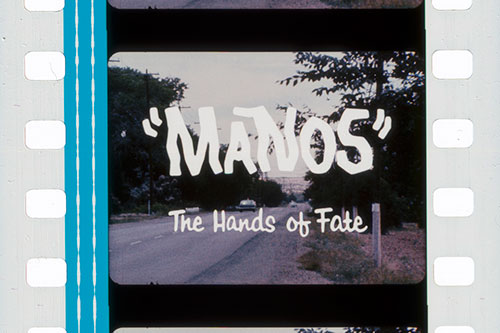 |
Many people have called Harold P. Warren’s Manos: The Hands of Fate the worst movie ever made. I must respectfully contradict those people, Manos cannot be the worst movie in a world in which Barry J. Gillis’ 1989 Things exists. Odds are it’s not even the worst American movie ever made, though the need for a snappy headline once resulted in me describing Manos as such. (And those words keep coming back to haunt me.)
The peculiarly-paced story of a deeply uncharismatic man (director Warren) taking his wife Margaret (Diane Mahree) and daughter Debbie (Jackey Neyman) on a vacation that runs afoul of a cult led by the plurally-married Master (Tom Neyman) and his jittery, big-kneed manservant Torgo (John Reynolds), Manos‘ reputation comes in no small part from being featured on what is considered the funniest and best episode of Mystery Science Theater 3000. (I also must respectfully disagree with on both counts, because for as great as the Manos episode is, for me it runs a very close second to Monster a-Go-Go.) Were it not for that reputation, a man named Ben Solovey might not have decided to restore Manos to the 2k digital glory it never came close to having in the first place. But Solovey did restore Manos, coming out soon on DVD and Blu-ray from Synapse Films. I talked to him about the ups and downs of such a perfectly strange project.
As he tells it in a post entitled “Why ‘Manos’?” on the restoration’s website and over email with me, Solovey acquired a carload of 16mm and 35mm film prints that had previously belonged to the long-defunct Emerson Film Enterprises. Among them was a theatrical release print of Manos: The Hands of Fate, slightly faded but in decent enough shape, all things considered. Another was set of A/B rolls – that is, the actual 16mm Ektachrome reversal film that passed through Harold Warren’s Bell & Howell camera, surely the most historically significant Bell & Howell this side of Abraham Zapruder’s – covering about half of the film’s running time. But the real find was the workprint, which changed everything.
 |
The trick about the cost-efficient on 16mm Ektachrome reversal film on which Manos was shot is that there was never a negative: when the film from the camera was developed, what resulted was the actual picture, not a negative thereof. That developed film was then duplicated for editing, eventually being assembled into the workprint that Solovey now possessed. It’s a minor miracle that the workprint survived not only standard disposal, but also the 1994 Northridge Earthquake which (according to Emersons) destroyed all the other extant Manos materials. And it’s pretty, too, thanks to the inherent hardiness of Ektachrome material.
The few audiences that saw Manos at the time certainly didn’t get to see anything as spiffy as the workprint. Once editing was complete, a 35mm blowup was made – making the picture twice as grainy – and prints for theaters were copied from that blowup. Not a single fuck was given about framing or color by the people who made those prints, resulting in a badly cropped picture with much of the color drained out. When the film hit VHS decades later, it was based on the horrible theatrical prints, and of course VHS is not exactly an archival format, so it made the picture look that much worse.
Here’s how it’s been looking from the VHS dupes, minus the MST3k silhouettes:
 |
…and here’s how it appeared on the (unrestored) workprint:
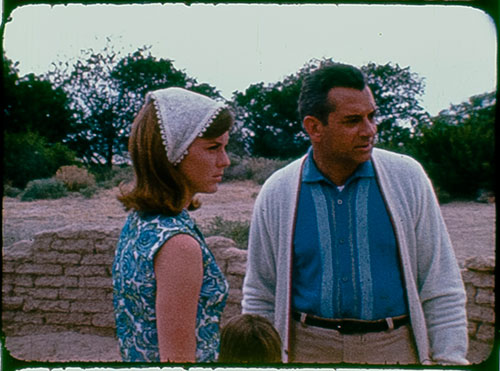 |
And the final restored version, from an advance DVD supplied to me by Mr. Solovey:
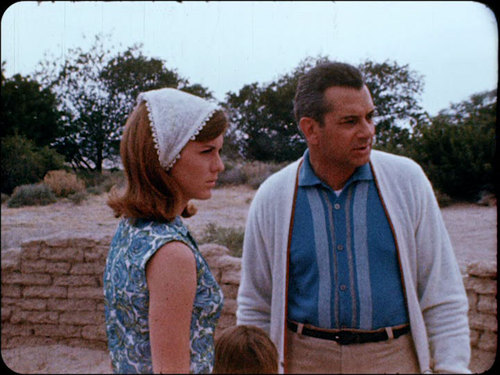 |
There was still plenty of ick to clean from the workprint in order to allow the ick of the set to shine though.
Before:
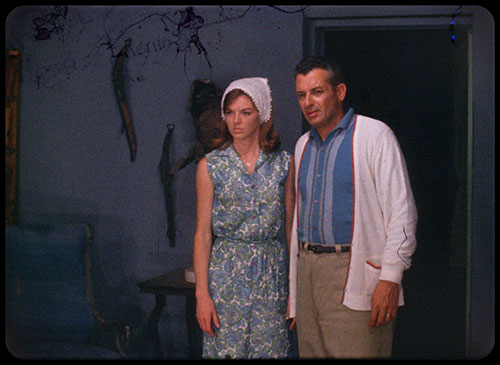 |
After:
 |
I need to stress that the above500px screenshots are in not truly representative of the actual resolution of Mr. Solovey’s 2k restoration; visit the Manos in HD site to them in their proper 2040×1491 size. (Be sure to click on the image once you get there to get to savor every grain.)
And here are some moving examples – “moving” in that they are motion pictures, though darn if they don’t also get me a little verklempt:
Okay, so Manos isn’t revealed to be an unheralded wonderland for the rods and cones – and even if it had been filmed in 3-Strip Technicolor, we’re still talking about a pretty damn scrubby area of El Paso – but Solovey’s 2k restoration does look a hell of a lot better, allowing us to enjoy Harold P. Warren’s paunch in all its glory.
I’ve grown intimately familiar with the restored version, having created subtitles for its theatrical premiere in San Francisco at my weekly movie riffing show Bad Movie Night, and in my opinion, the sprucing up makes the film seem far more intimate. Even the shape of the frame is important; there’s always been an allure to those rounded edges, conferring a (sometimes unearned) legitimacy that makes it feel like you’re spying on the subjects. You’re as close as you can possibly get, and everything you’re seeing is exactly how it happened that day at the light hit the film. (For the moment, please forget that Instagram exists.)
This is doubly true for a film like Manos, which has no optical effects and is about as WYSWYG as movie can be. Even with the editing – and there is plenty of editing, since the limitations of the camera resulted in takes no longer than 32 seconds, so Rope it ain’t – this cleaned-up, fully-uncropped makes Manos almost feels like a documentary of its own making.
Nor is it quite the same content-wise as the familiar public domain / Mystery Science Theater 3000 versions. “There’s a little more material at the beginning and middle of the film than the MST3K version,” Mr. Solovey told me, “and, as it was our only source for a good portion of the film, there are some slight editorial differences in the workprint that found their way into the final version: some shots are a little longer, some are a little shorter. That being said, the workprint is just as it came from the editing table, so it’s possible that these minor differences were the preference of the director and editor: the out-of-synch sound often seems to match it better. The most notable scene cut from the MST3K version is one in which The Master slaps around a disobedient wife, smearing fake blood on her face, while she laughs at the loss of his powers. It’s a little too stagy to take seriously.”
That Manos: The Hands of Fate now borders on visually watchable only adds to what’s kept it popular for the past two decades: the fact that it’s just so damned odd, and it comes by that oddness organically. The picture has the most important hallmark of the true cult film: it doesn’t know that it’s a cult film. There’s nothing self-aware about Manos on any level, the audience is never winked at, and there’s no weirdness for weirdness’ sake. Like many truly bad films, it was made a director who was trying to make a truly good film, but who was hampered by having absolutely no idea what he was doing.
Thankfully, the person doing the restoring has a much better idea of what he’s doing, because unlike Manos director Warren, he actually works in the film industry. “I’m a Director of Photography and a Steadicam-certified camera operator,” said Mr. Solovey, who’s also experienced with the ubiquitous RED digital camera. “I’ve worked on variety of projects, from EPKs to a couple of independent features.”
A neat-looking series Mr. Solovey shot:
Solovey was trained on 16mm film in school, but moved to Los Angeles just in time for the seismic shift to digital. As with everything, networking is key: “Knowing plenty of smart people in post-production was extremely helpful when planning a project of this magnitude.”
And it’s a project that a lot of people are looking forward to. Though Manos: The Hands of Fate is nowhere near a household word – unlike, say, Plan 9 from Outer Space, which even the most mainstream of moviegoers have heard of – the response to the Kickstarter was nothing short of astonishing. The goal of the Kickstarter was a mere $10,000, but by the time the 41-day funding period was over, 818 backers had donated a total $48,130. I’m no good at math, but I’d wager that over half of those backers donated after the initial goal had been reached – and Mr. Solovey told me that the original goal of $10,000 “would have been enough to fund a good, albeit dirty, transfer and a simple, self-distributed disc” – because they wanted to see the movie, and they wanted the final product to be as good as it could be.
Because of that generosity, there’s not only a 2K DCP version available that’s compatible with today’s modern pixels-only theaters, but also 16mm and 35mm prints. Plus, there’s that features-packed release from Synapse Films which will be emerging sometime in 2014.
Manos was considered an instant classic from its first broadcast on Mystery Science Theater 3000 – when it was screened at the Mystery Science Theater 3000 CoventioCon ExpoFest-A-Rama 2: Electric Bugaloo in 1999, everyone clearly knew it by heart – but the film keeps inspiring people to new heights of weirdness even outside of the MST3K. There have been at least two live productions that I’m aware of, one of which was by Last Rites Productions in Portland all the way back in 2006…
…and another all the way back in 2013 by Capital I Productions, also in Portland.
But what if you were in the Pacific Northwest, but didn’t want to see Manos: The Hands of Fate performed by humans? You got thee to Seattle for Manos: The Hands of Felt, that’s what you did. And if you missed that, it’s coming to DVD and Amazon Instant Video soon.
Still, I know you kids these days, with your hula hoops and your chocolate sodas and your hand-held personal electronic entertainment mechanisms. If it doesn’t involve moving your thumbs and/or shooting things, you don’t wanna know about it. So, fine. Play the Manos: The Hands of Fate video game. See if I care.
This is a strangely fertile time for Manos: The Hands of Fate – I’m writing this to the kickin’ sounds of Manos: The Remix of Fate, a collection of remixes of the Manos soundtrack Mr. Solovey sourced from the workprint – and all the more prefect for the restoration to be released upon a clearly willing world.
I asked Mr. Solovey what the most satisfying part of the project has been. He replied, “To watch the film, with no special comedic accompaniment, alongside a crowd in El Paso. Murmurs of recognition, gasps at the time capsule-like views of the local scenery, plenty of groans, and steadily growing laughter as the awkward silences in the film became funnier than any joke. We played right after Rocky Horror, so there were several appropriately-dressed people in the audience with us. Afterward, I met an elderly couple who had actually attended the premiere back in 1966. They said the picture looked better in our restoration, which was the highest compliment we could have hoped for.”
 |
| From back when it didn’t look so good. |
What about the most frustrating part? “As you’d expect, facing up to our limitations along the way has sometimes been frustrating. The fact that the film elements survived at all is incredible, but the damage was often beyond the capability of the restoration tech we could afford. The final budget, minus the inherent costs of Kickstarter, was enough to create a proper retail release if we stretched it, but by a distributor like Synapse’s standards it was downright scant. I elected to go for it anyway because I figured this film had just this one shot at a proper retail release, and enough people interested now to make it worthwhile. Everyone I hired to work on the restoration got paid for their labor from the Kickstarter budget, including the editor handling the supplements.
“To save money and time, I learned how to use the restoration software myself, though I left the most prominent fixes to an expert acquaintance. Watching it today, I only see the flaws that we had to leave in, or the less-than-perfect fixes from our slightly-dated restoration tech. Still, the film has become much more watchable and, most importantly, the audience responds to it in a big way.”
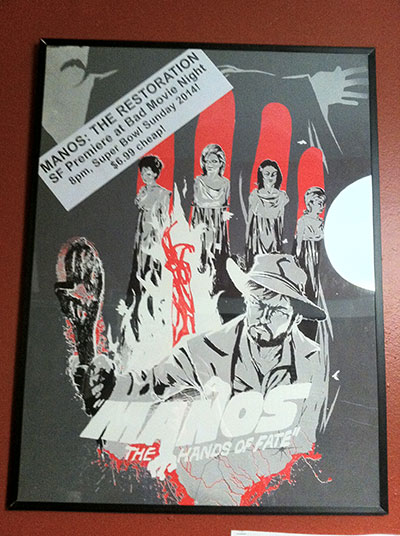 |
Since I had to pause on nearly every shot while making the subtitles, little details that I’d never noticed popped out at me. (And, again, it helps that we’re seeing much more of the picture than ever before.) Way up on that list for me is the beer bottle in Torgo’s room. It just seems to explain everything, doesn’t it? Mr. Solovey said that one of his favorite details is also in Torgo’s room: “The unused Wife’s dress hanging next to a rope on the wall. I concluded that the dress was intended for Margaret, and the rope was intended for Michael. When I ran that theory by [costume designer, art director, and “The Master”]Tom Neyman, he thought about it and said that ‘We probably just thought the wall looked too bare.'”
 |
Where to go now? I asked Mr. Solovey what his dream restoration project would be, inasmuch as anything could top Manos. “My first dream restoration is a secret, just in case I actually get to do it. My second dream project would be a 3D Blu-ray of Robot Monster. It’s not in the public domain, and I know some experts in the 3D arena who would love to be involved in fixing it up, but so far there’s no sign that the rights-holders consider it a worthwhile venture. Normally, I think 3D is more fun to shoot than it is to watch, but Robot Monster is a completely different film when seen in 3D: the use of depth is very experimental and highly entertaining.”
We wouldn’t be talking about Manos: The Hands of Fate at all if one Harold P. Warren hadn’t been determined to make a movie, and we thank him for that. Now that he probably knows Manos better than even Warren ever did, what piece of advice would Mr. Solovey give him?
“To keep making films. I’d definitely watch them.”
Word.
Previously by Sherilyn Connelly:
The 5 Coolest Things About the Navajo Translation of Star Wars
The Nineteen Coolest Illustrations from Star Trek Fanzines
The 9 Coolest Sci-Fi Read-Along Records from the 70s and 80s
15 Awesomely Nerdy Behind-the-Scenes Documentaries You Can Watch for Free Right Now
The Eight Funniest Recurring Themes in the Original Star Wars Trading Cards
The Six Coolest Things In Starlog #001: The Voyage in Retro-Nerdery Begins
